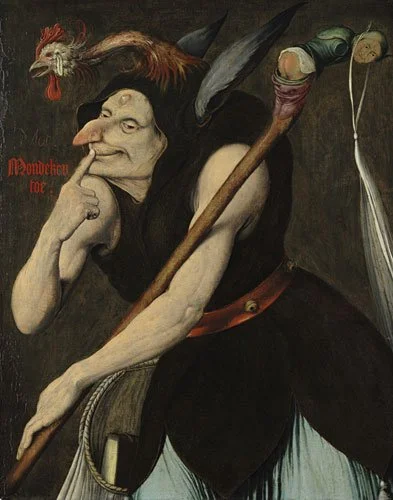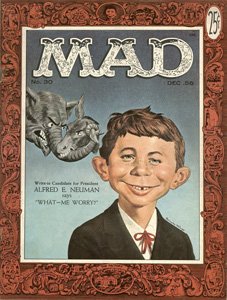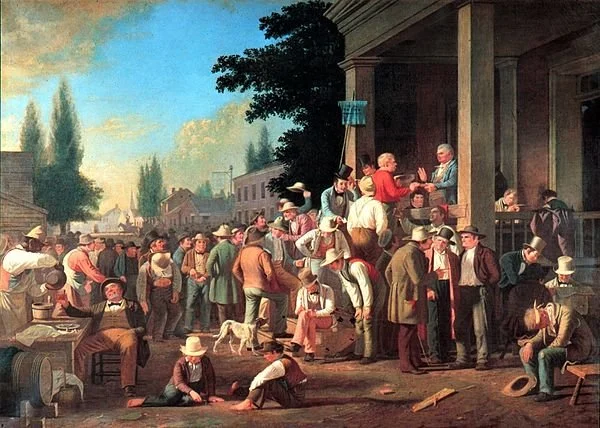
David Warsh: Tim Ryan says time to ‘Leave the age of stupidity behind us’
“An Allegory of Folly” (early 16th century), by Quentin Matsys
— EC Publications
SOMERVILLE, Mass.
It was the one ostensible mistake I made in what I wrote about the run-up to what did in fact turn out to be a nobody-knows-anything election.
To my mind, the most interesting contest in the country is the Senate election involving 10-term Congressman Tim Ryan and Hillbilly Elegy author J. D. Vance, a lawyer and venture capitalist. That’s because, if Ryan soundly defeats Vance, he’s got a good shot at becoming the Democratic presidential nominee in 2024.
Even now I don’t think that I was altogether wrong.
Thanks to the editorial page of The Wall Street Journal, we know why Ryan lost. Vance, who was on the ballot because Donald Trump endorsed him, trailed Ryan by significant margins until mid-summer. That was when Senate Minority Leader Mitch McConnell invested more than $32 million in the Ohio Senate race, via a super-PAC he controlled, 77 percent of all Republican campaign media spending in the Ohio election after mid-August. Most of it was negative “voter education,” enough to tip the balance against “taxing-Tim” for having voted for various Biden measures. The power of money in American elections may be a scandal, but by now it has been well-established by the Supreme Court as a fact of life.
It seems nearly certain to me that the next president will be someone born in the ‘70’s, not the ‘40’s. New York Times columnist Ross Douthat was probably correct when he wrote last week that Florida Gov. Ron DeSantis is likely to be the Republican nominee. DeSantis, 44, was born in 1978.
Douthat may have been wrong, however, in thinking that DeSantis’s “sweeping success” in his re-election campaign validated the theory that “normal” doesn’t have to mean “squishy.” The tough-guy approach worked well in Florida. DeSantis was “an avatar of cultural conservatism, a warrior against the liberal media and Dr. Anthony Fauci, a politician ready to pick a fight with Disney if that’s what the circumstances require.”
But a better-mannered Donald Trump may not be what the majority of voters will be looking for in the next election. Tim Ryan, 49, was born in 1973. If you have time, and want a lift, watch Ryan’s 15-minute concession speech to get a feel for the man. Pay special attention to the six-minute mark, where Ryan speaks to the audience beyond the room he is in.
The words in that middle portion of that speech strike a powerful chord: “This country, we have too much hate, too much anger, there is way too much fear, way too much division. We need more love, more compassion, more concern for each other. These are important things. We need forgiveness, we need grace, we need reconciliation. We do have to leave the age of stupidity behind us.”
There are many question to be answered. First among them: are Ryan and his family willing to undertake a two-year front porch campaign? If so, a 10-term former congressman has a reasonable chance to win both the Democratic Party’s nomination, and the 2024 election itself.
David Warsh, a veteran columnist and an economic historian, is proprietor of Somerville-based economicprincipals.com, where this column first appeared.
David Warsh: The mid-terms, ‘national conservatism’, U.K. confusion, Anglo-Saxon invasion
Ohio Democratic Congressman and U.S. Senate candidate Tim Ryan
SOMERVILLE, Mass.
The way I see it, the United States and its NATO allies goaded Vladimir Putin into a war that Russia cannot hope to win and which Putin is determined not to lose. What will happen next? The U.S. mid-term congressional elections, that’s what.
Interesting election campaigns are unfolding all across the nation. I take everything that Republican Party strategist Karl Rove says with a grain of salt, but suspect he is correct when he predicts the GOP will pick up around 20 seats in the House in November, enough to give Trumpist Republicans a slender majority there for the next two years. The Democrats likely will control the Senate, setting the stage for the 2024 presidential election.
To my mind, the most interesting contest in the country is the Senate election involving 10--term Congressman Tim Ryan and Hillbilly Elegy author J. D. Vance, a lawyer and venture capitalist. That’s because, if Ryan soundly defeats Vance, he’s got a good shot at becoming the Democratic presidential nominee in 2024. Ryan and Vance have agreed to two debates, Oct. 10 and 17.
By ow, it goes practically without saying that President Joe Biden will not run for re-election on the eve of turning 82. Ryan, who will be 51 in 2024, challenged House Speaker’s Nancy Pelosi’s leadership of the Democratic Party party in 2016, and sought the party’s presidential nomination in 2020.
A demonstrated command of the battleground states of the Old Northwest – Ohio, Pennsylvania, Michigan and Wisconsin – would make Ryan a strong contender against Florida Gov. Ron DeSantis, the likely Republican nominee.
It was a turbulent week. Having proclaimed Russia’s annexation of four Ukrainian regions, Putin delivered what Robyn Dixon, Moscow bureau of The Washington Post, described as “likely the most consequential” of his 23 years in office. But rather than a clarion call to restore Russian greatness as he clearly intended,” she wrote, “the address seemed the bluster and filibuster of a leader struggling to recover his grip — on his war, and his country.”
A starling miscalculation by Britain’s new Conservative Party government threatened to destabilize global financial markets. And the costs of gradual global warming continue to make themselves clear.
In the midst of all this, an old friend called my attention to two essays that seemed to take antithetical views of the prospects. The first, “How Europe Became So Rich’’, by the distinguished economic historian Joel Mokyr,
Many scholars now believe, however, that in the long run the benefits of competing states might have been larger than the costs. In particular, the existence of multiple competing states encouraged scientific and technological innovation…. [T]he ‘states system’ constrained the ability of political and religious authorities to control intellectual innovation. If conservative rulers clamped down on heretical and subversive (that is, original and creative) thought, their smartest citizens would just go elsewhere (as many of them, indeed, did).
Mokyr concluded, “Far from all the low-hanging technological fruits having been picked, the best is still to come.”
The second, “Seven Years of Trump Has the GOP taking the Long View’’, by long-time newspaper columnist Thomas Edsall, cites the success of Viktor Orban in governing Hungry, and then examines various signs of the vulnerability of the liberal state in America. These include the durability of the Trump base, and an incipient “National Conservatism” project, created in 2019 by the Edmund Burke Foundation, since joined by an array of scholars and writers associated with such institutions, magazines and think tanks as the Claremont Institute, Hillsdale College, the Hoover Institution, the Federalist, the journal First Things, the Manhattan Institute, the Ethics and Public Policy Center and National Review.
What characterizes national conservatism? Commitments to the infusion of religion and traditional family values into the government sphere, Edsall says, and, perhaps especially, opposition to “woke progressivism,” Conservative Conference chairman Christopher DeMuth puts it this way: Progressives promote instability and seek “to turn the world upside down:”
[M]ayhem and misery at an open national border. Riot and murder in lawless city neighborhoods. Political indoctrination of schoolchildren. Government by executive ukase. Shortages throughout the world’s richest economy. Suppression of religion and private association. Regulation of everyday language — complete with contrived redefinitions of familiar words and ritual recantations for offenders.
All I could do in reply was to take comfort in evidence that borders have been open to chaotic traffic for a very long time, across barriers more intimidating than the Rio Grande River, resulting in successful assimilation. Science magazine (subscription required) reported last month that new archaeological evidence tends to support the traditional view of “How the Anglo-Saxons Settled England”.
An 8th Century (C.E.) history written by a monk named Bede asserted that Rome’s decline in about 400 C.E. opened the way to an invasion from the east. Tribes from what is today northwestern Germany and southern Denmark “came over into the island, and [the Angles, Saxons, and Jutes] began to increase so much, that they became terrible to the natives.”
For a time, archaeologists doubted Bede’s account, preferring to think that only a relatively small bands of warrior elites could have successfully imposed their culture on the existing population. “Roman Britain looks very different from the Anglo-Saxon period 200 years later,” one archaeologist acknowledged to Science. But DNA samples from the graves of 494 people who died in England between 400 and 900 show they derived more than three-quarters of their ancestry from northern Europe.
The results address a long-standing debate about whether past cultural change signals new people moving in or a largely unchanged population adopting new technologies or beliefs. With the Anglo-Saxons, the data point strongly to migration, says University of Cambridge archaeologist Catherine Hills, who was not part of the research. The new data suggest “significant movement into the British Isles … taking us back to a fairly traditional picture of what’s going on.”
That doesn’t mean that the migration was especially turbulent, as when the Vikings began raiding a few centuries later, leaving relatively few genetic traces behind. Language changed relatively quickly after the Anglo-Saxons began arriving, a sign that people were talking, not fighting. Integration and intermarriage persisted for centuries. Indeed, archaeologists discovered “one high status woman in her 20s with mixed ancestry was laid to rest near modern Cambridge under a prominent mound with silvered jewelry, amber beads, and a whole cow.” That suggests more complexity than simple conquest, one archaeologist told Science.
Same as it ever was, in other words – all but the cow.
David Warsh, a veteran columnist and an economic historian, is proprietor of Somerville-based economicprincipals. com
David Warsh: Three to watch in the mid-term elections
An 1846 painting by George Caleb Bingham showing a polling judge administering an oath to a voter
SOMERVILLE, Mass.
My Fourth of July resolution was to tune out stories about the possible 2024 presidential ambitions of Donald Trump and Hillary Clinton, and pay attention instead, at least until Nov. 8, to the Senate campaign in Ohio. Author-turned-venture capitalist J.D. Vance and Congressman Tim Ryan are running there to succeed retiring Republican Sen. Rob Portman.
Vance, 37, gained fame as author of Hillbilly Elegy: A Memoir of a Family and Culture in Crisis (2016). After high school, he enlisted in the U.S. Marine Corps and served as a public-affairs specialist in an air wing during the Iraq War. He then graduated from from Ohio State University, went on to Yale Law School and then left a corporate-law practice for a venture-capital firm in San Francisco. He returned to Ohio in 2016 to form, with partners, a venture fund of his own. Formerly an evangelical Protestant, he converted to Roman Catholicism in 2019. He opposes abortion rights.
Ryan. 49, is a 10-term congressman whose present district includes much of northeast Ohio, from Youngstown to Akron. In 2015, he explained to readers of the Akron Beacon Journal “Why I changed my thinking on abortion’’. The next year, he led an ultimately unsuccessful effort to unseat Nancy Pelosi as party leader of the House Democrats.
Might Ryan, if he wins, find a seat on that otherwise still all-but-empty bench of potential 2024 Democratic presidential candidates, at whose opposite end sits Clinton? It is plausible, if not likely. After all, former Ohio Gov. John Kasich had a shot at derailing Trump as Republican nominee in 2016. In any event, lie Vance, Ryan seems likely to remain in public life for years to come.
Jane Coaston, a journalist, is a third star rising in the mid-term elections, and probably well beyond. The New York Times hired her away from Vox last autumn to run a weekly discussion show, The Argument. Coaston grew up in suburban Cincinnati, according to Graham Vyse, of The Washington Post, the daughter of union Democrats who were “giant hippies,” before she learned to distinguish among varieties of conservative thought as editor of The Michigan Review at the University of Michigan. She gained prominence with a National Review article in 2017, “What if there is no such thing as Trumpism?” Her talk-show discussion with two leading Republican theorists after Vance’s Trump-endorsed primary victory in May was especially illuminating.
Control of the Senate will almost certainly become the dominant story of the mid-term elections. The Pennsylvania Senate race is interesting, too. To me, at least, it seems likely, that the Supreme Court’s decision to overturn Roe v. Wade will cost Minority Leader Mitch McConnell (R-Kentucky) his leadership of the Senate. This column is mostly about economics, but the investigation of preferences change is gradually becoming an important part of economics
Immigration, foreign wars, globalization and climate change: All these national issues will take a back seat in November elections, which are about leadership in particular states. They will resurface, along with women’s rights, in 2024. Harvard Historian Jill Lepore wrote a couple years ago that America, like any other nation-state, requires a “national story.” She was right. Voters write it, election by election.
David Warsh, a veteran columnist, is proprietor of Somerville-based economicprincipals.com, where this essay originated.







